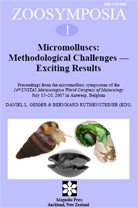Abstract
Until recently the systematics of the Skeneidae (type species Skenea serpuloides Montagu, 1808) has been solely based on shell characters, radula details and external morphology. However, methodological progress (e.g. SEM) and preliminary anatomical data suggest that this vetigastropod group represents a polyphyletic, “skeneimorph” assemblage. Serial semithin sectioning combined with computer-aided 3D-reconstruction permits the detailed anatomical investigation of such small (1–3 mm), helicoid gastropods.The taxa for which micro-anatomical data are available include six skeneimorph species from six genera: (1) True Skeneidae, exemplifi ed by the type species, Skenea serpuloides (Montagu, 1808), doubtlessly belongs to Vetigastropoda and probably rests within the Trochoidea/Turbinoidea. Apomorphies of Skenea and related genera include a penis formed by the right propodium. (2) Bathyxylophila excelsa Marshall, 1988, Ventsia tricarinata Warén & Bouchet, 1993 and an undetermined “skeneimorph vetigastropod” have papillate cephalic and epipodial tentacles, a single monopectinate ctenidium with skeletal rods and bursicles, a papillary left and a right excretory organ, and statocysts with several statoconia. All these characters are indicative for a position of these species inside Vetigastropoda. Distinct appearance of epipodial tentacles and the lack of a combined epipodial sense organ argue against an inclusion into Trochoidea/Turbinoidea and thus Skeneidae s.s. (being defi ned by the characteristics of Skenea serpuloides). At present, these species cannot be classifi ed in any known vetigastropod subclade. (3) Leptogyra constricta Marshall, 1988 and Leptogyropsis kalinovoae Marshall, 1988 both are characterized by smooth cephalic and epipodial tentacles, a single, left excretory organ and statocysts with one statolith. These anatomical data strongly suggest a systematic position in the likewise rhipidoglossate Neomphalina, which might be considered as an independent rhipidoglossate clade outside the Vetigastropoda.
Although we are still at the very beginning in our investigation of skeneimorph anatomies, it is clear that this polyphyletic assemblage needs to receive much more attention for a complete understanding of vetigastropod and neomphalinan phylogeny.

